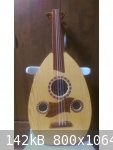jin2678
Oud Admirer

Posts: 1
Registered: 2-8-2018
Member Is Offline
|
|
Question about tuning a 9 string oud
Hello,
I recently got an oud as a present from friends and i got it with 9 strings with the ability to add the extra higher 2 strings.
I searched online for multiple tunings and tried the (from lowest string to highest) C-F-A-D-G but I feel like the C string is a little too loose and
the A string is definitely too loose..
I added a picture I took of it in hope that anyone here knows of an alternate tuning that might work better for my oud.
Thanks in advance!

|
|
|
SamirCanada
Moderator
     
Posts: 3405
Registered: 6-4-2004
Member Is Offline
|
|
Looks like a children size oud.
Can you measure the length of the strings from bridge to nut.
@samiroud Instagram
samiroudmaker@gmail.com
|
|
|
Giorgioud
Oud Junkie
    
Posts: 287
Registered: 11-18-2011
Location: United Kingdom
Member Is Offline
Mood: Oudbsessed
|
|
Your oud looks like it used to be a 6-course oud and then the nut has been replaced with one that accommodates just 5 courses. The asymmetry of the
thinner strings on the fingerboard and the bridge tell us that. Nothing wrong with it, it is a quick way to convert a Standard Arabic oud into a
5-course one.
Anyway, this is the way you have to tune your oud. The way you tuned it is not correct, hence the extreme looseness of the strings you mentioned. On a
5-course (or 9-strings) oud there is no C. There are a few ways to tune it, depending on your taste and your influences. But the following ones are
the established tunings that have been used by the greats of past times and still used by a selected few in the present.
So, from thinnest strings to thickest (lower case letter represent the plain nylon strings, capital case the wound strings):
cc, gg, DD, AA, F (called Syrian or Egyptian tuning)
cc, gg, DD, AA, G (variant of the Syrian/Egyptian)
cc, gg, DD, AA, E (Lebanese tuning)
cc, gg, DD, AA, D (Algerian tuning)
cc, gg, DD, BbBb, F (rarely used)
Hope that helps.
|
|
|
Giorgioud
Oud Junkie
    
Posts: 287
Registered: 11-18-2011
Location: United Kingdom
Member Is Offline
Mood: Oudbsessed
|
|
One correction about your oud: at a closer inspection it appears that the third course (course = two strings), the DD, is not wound, which is quite
common. So, when trying out the tunings, pretend the third course as being wound (because I used capital letters in writing it as though it was wound)
despite the fact it is a plain nylon dd. Hope it is clear.
|
|
|
|